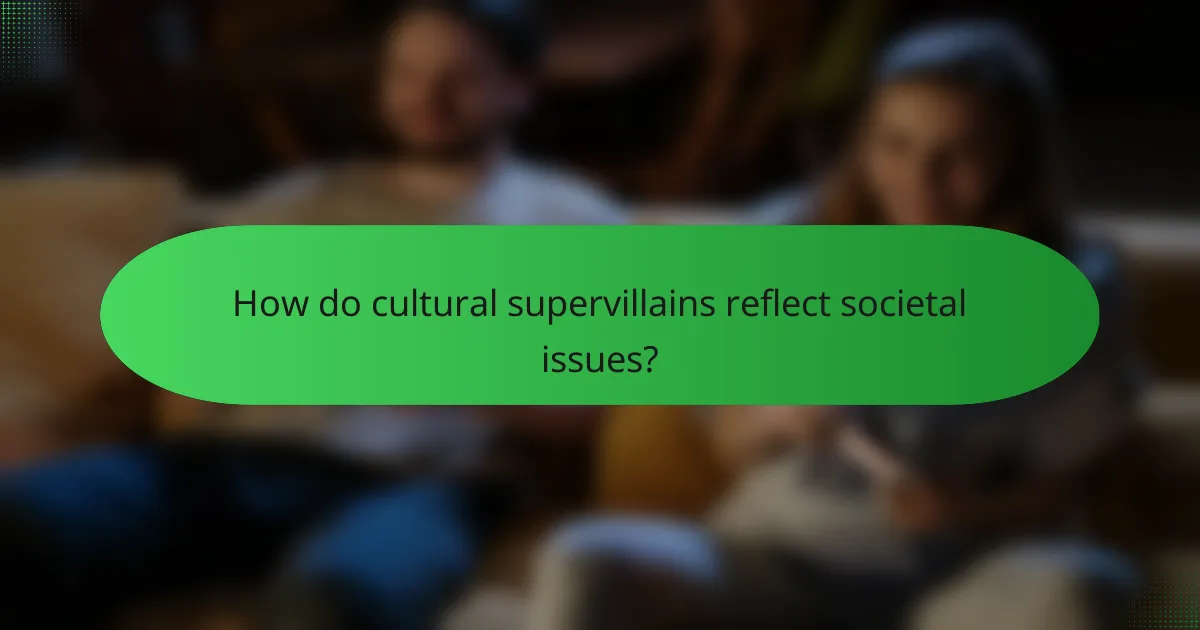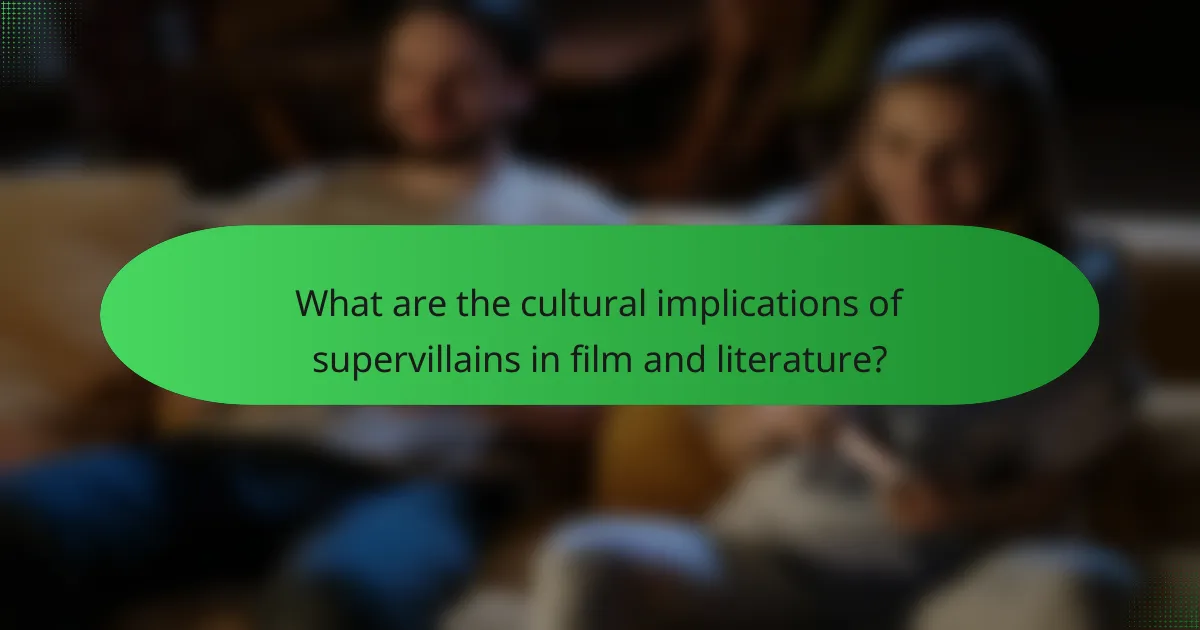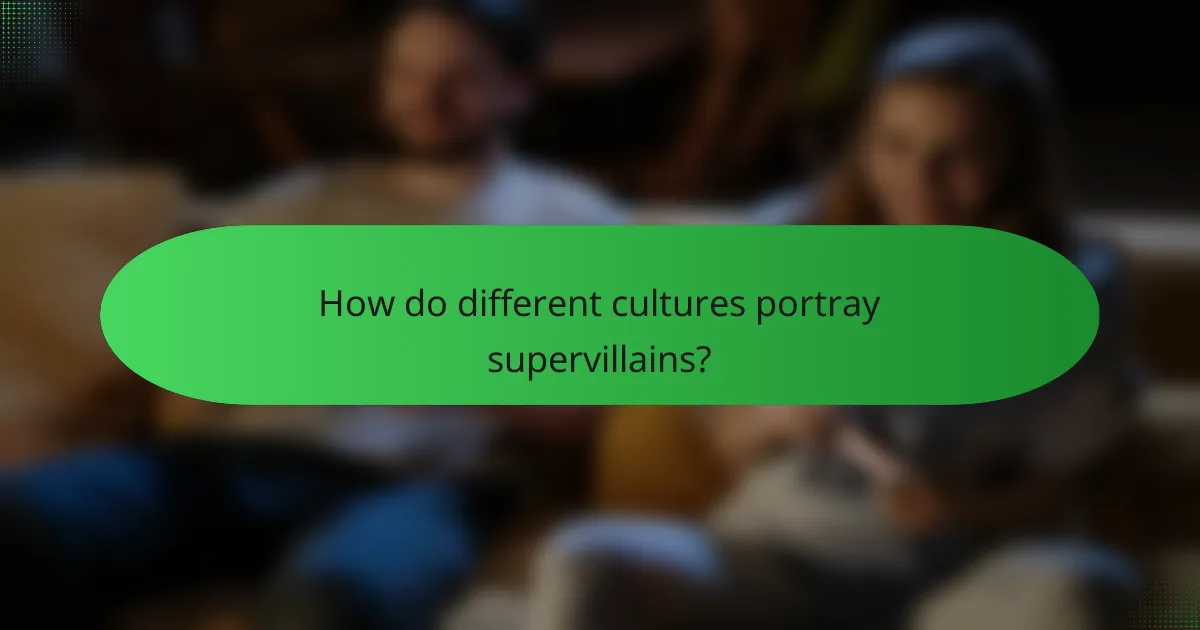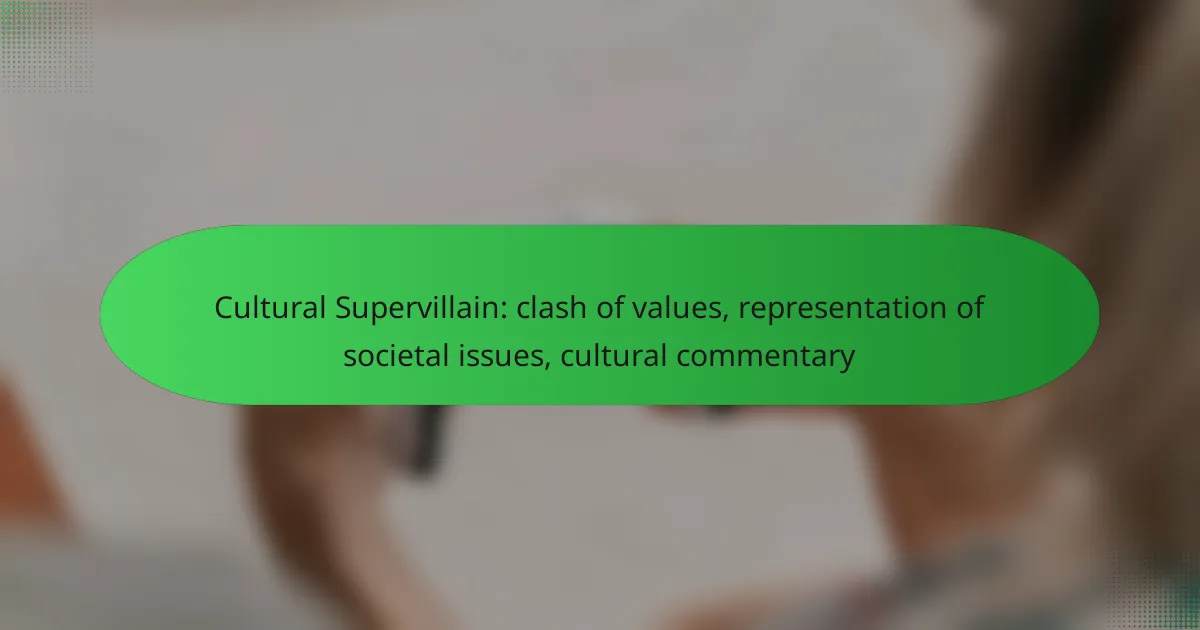Cultural supervillains act as reflections of societal issues, encapsulating the fears and aspirations of diverse communities. By challenging norms and provoking thought, they serve as powerful tools for cultural commentary, allowing audiences to engage with complex themes and conflicts. These multifaceted characters not only highlight societal contradictions but also shape media narratives, making them significant in understanding cultural dynamics.

How do cultural supervillains reflect societal issues?
Cultural supervillains serve as mirrors to societal issues, often highlighting the struggles and conflicts faced by various communities. They embody the fears, frustrations, and aspirations of society, making them powerful tools for cultural commentary.
Representation of marginalized communities
Cultural supervillains frequently represent marginalized communities, showcasing their experiences and challenges. By embodying the anger and resistance of these groups, they bring attention to social injustices and inequalities that may otherwise be overlooked.
For example, characters like Killmonger from the Marvel universe illustrate the complexities of identity and systemic oppression, resonating with audiences who share similar backgrounds. This representation can foster empathy and understanding among broader audiences, encouraging dialogue about these critical issues.
Critique of power structures
Cultural supervillains often critique existing power structures, revealing the flaws and corruption within societal systems. They challenge authority and question the status quo, prompting audiences to reconsider their own beliefs and the systems they support.
Characters like V from “V for Vendetta” exemplify this critique, as they fight against oppressive regimes and inspire rebellion. Such narratives encourage viewers to reflect on their roles within these structures and consider the implications of their actions.
Exploration of moral ambiguity
Cultural supervillains frequently embody moral ambiguity, blurring the lines between good and evil. This complexity invites audiences to grapple with ethical dilemmas and the motivations behind their actions, fostering deeper engagement with the narrative.
For instance, characters like Thanos from the Marvel Cinematic Universe present a rationale for their destructive actions, prompting viewers to question the morality of their choices. This exploration of moral gray areas can lead to richer discussions about justice, sacrifice, and the consequences of one’s actions in society.

What are the key characteristics of cultural supervillains?
Cultural supervillains are complex characters that embody societal fears and contradictions, often serving as reflections of the values and issues present in their respective cultures. They challenge norms and provoke thought, making them significant in cultural commentary.
Complex backstories
Cultural supervillains typically have intricate backstories that explain their motivations and actions. These narratives often highlight personal traumas, societal injustices, or moral dilemmas that shape their worldview. For example, a villain may have experienced discrimination, leading them to seek revenge against a system they perceive as oppressive.
Such depth allows audiences to empathize with these characters, blurring the lines between good and evil. This complexity invites viewers to reflect on their own values and the societal structures that influence behavior.
Symbolism of societal fears
Cultural supervillains often symbolize the fears and anxieties prevalent in society. They can represent issues like economic disparity, environmental degradation, or the consequences of technological advancement. For instance, a villain who manipulates technology might embody fears about privacy invasion and loss of control in a digital age.
This symbolism serves as a mirror, prompting audiences to confront uncomfortable truths about their world. By engaging with these characters, viewers can explore the implications of societal issues in a more accessible way.
Contradictory values
Cultural supervillains frequently embody contradictory values that challenge conventional morality. They may advocate for freedom while employing oppressive tactics, or seek justice through violent means. This duality forces audiences to question their own beliefs and the complexities of morality in real life.
For example, a villain who fights against corruption might resort to unethical methods, highlighting the struggle between idealism and pragmatism. Such contradictions encourage deeper discussions about the nature of good and evil, and the gray areas in between.

How do cultural supervillains influence media narratives?
Cultural supervillains play a significant role in shaping media narratives by embodying societal issues and reflecting cultural conflicts. They often serve as a lens through which audiences can explore complex themes, leading to deeper engagement with the content.
Shaping audience perceptions
Cultural supervillains influence how audiences perceive societal values and conflicts. By representing extreme versions of real-world issues, they challenge viewers to confront uncomfortable truths about morality, power, and justice. This can lead to shifts in public opinion, as audiences may empathize with or reject these characters based on their own beliefs.
For example, a villain who exploits economic inequality may prompt viewers to reflect on their own societal structures and the implications of wealth disparity. This reflection can foster a greater awareness of social justice issues.
Driving plot development
Cultural supervillains are crucial in driving the narrative arcs of stories, often serving as catalysts for conflict and character development. Their motivations and actions create obstacles for protagonists, leading to tension and resolution that keeps audiences engaged. This dynamic can elevate the stakes of the story, making it more compelling.
For instance, a villain representing authoritarianism might force a hero to confront their own values regarding freedom and choice, creating a rich narrative that explores these themes in depth.
Creating dialogue on ethics
The presence of cultural supervillains in media sparks important discussions about ethics and morality. They often embody the darker aspects of human nature, prompting audiences to consider the implications of their actions and the societal norms that allow such behavior to flourish. This dialogue can lead to critical thinking about right and wrong in real life.
By presenting morally ambiguous characters, media can encourage viewers to question their own ethical frameworks and the societal structures that influence their decisions. This reflection is essential for fostering a more informed and engaged audience.

What are the cultural implications of supervillains in film and literature?
Supervillains in film and literature serve as powerful symbols reflecting societal values and conflicts. They often embody contemporary issues, challenge cultural identities, and provide commentary on the human condition, making them significant figures in storytelling.
Reflection of contemporary issues
Supervillains frequently mirror pressing societal concerns, such as inequality, corruption, and environmental crises. For instance, characters like Lex Luthor highlight corporate greed, while others, like Killmonger from Black Panther, address racial injustices. These portrayals encourage audiences to confront and discuss these issues through the lens of fiction.
Moreover, the motivations behind these villains often stem from real-world frustrations, allowing viewers to empathize with their struggles, even if their methods are extreme. This duality prompts reflection on moral complexities and societal norms.
Impact on cultural identity
Supervillains can significantly influence cultural identity by challenging stereotypes and redefining what it means to be “good” or “evil.” Characters from diverse backgrounds, such as V from V for Vendetta, can resonate with marginalized groups, fostering a sense of representation and empowerment. These narratives often encourage audiences to question their own cultural narratives and values.
Additionally, the portrayal of villains can reinforce or dismantle cultural myths, impacting how communities perceive themselves and others. This dynamic can lead to a richer understanding of identity and the factors that shape it.
Representation in diverse genres
Supervillains appear across various genres, each offering unique perspectives on cultural issues. In superhero comics, villains often symbolize the antithesis of societal ideals, while in horror films, they may represent internal fears and societal anxieties. This versatility allows for a broad exploration of themes relevant to different audiences.
Genres like science fiction and fantasy also utilize supervillains to critique contemporary society through allegory. For example, dystopian narratives often feature tyrannical figures that reflect real-world authoritarianism, prompting discussions about governance and freedom. This diversity in representation enriches the cultural commentary embedded in these stories.

How do different cultures portray supervillains?
Different cultures portray supervillains in ways that reflect their unique societal values, fears, and historical contexts. These representations often serve as a commentary on cultural issues, illustrating how villainy is perceived and understood across various societies.
Western vs. Eastern interpretations
In Western cultures, supervillains often embody individualism and personal ambition, frequently depicted as charismatic figures who challenge societal norms. Characters like Lex Luthor or the Joker highlight the conflict between personal desires and societal expectations.
Conversely, Eastern interpretations may focus on collective values and the consequences of one’s actions on the community. Villains in Asian narratives, such as those in anime or folklore, often represent societal fears or historical grievances, emphasizing the importance of harmony and the impact of personal choices on the greater good.
Historical context of villainy
The portrayal of supervillains is deeply rooted in historical events and cultural narratives. In the West, the rise of the anti-hero in the late 20th century reflects societal disillusionment with authority and traditional morality, showcasing villains who challenge the status quo.
In contrast, Eastern cultures may draw from historical conflicts, such as colonialism or war, to shape their villains. These characters often serve as reminders of past injustices and societal struggles, reinforcing the need for unity and resilience in the face of adversity.
